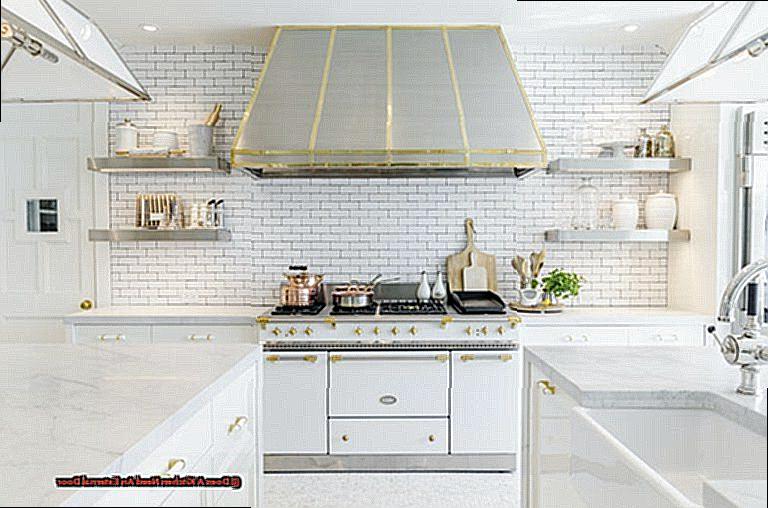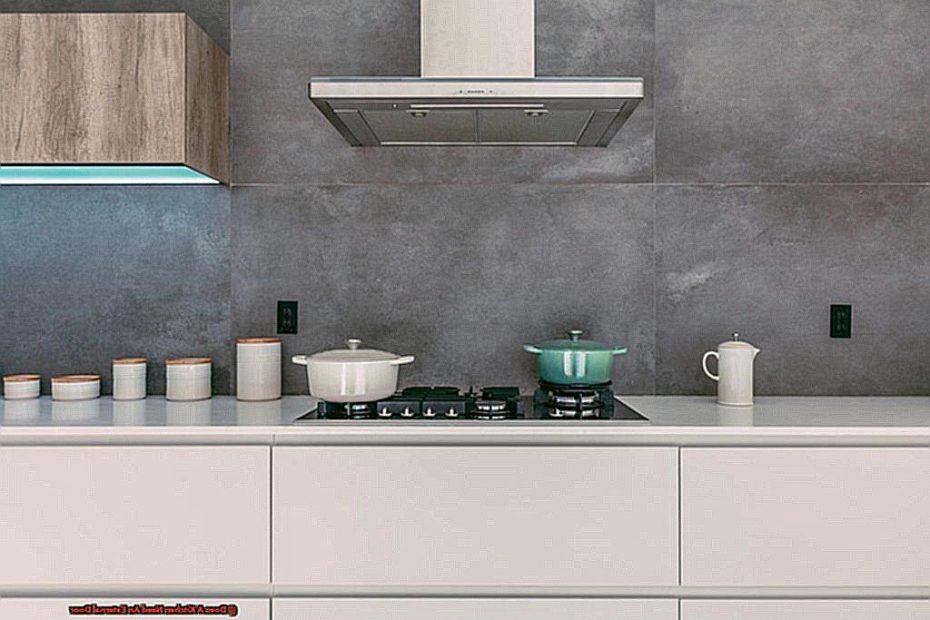Imagine this: you’re in the midst of creating a mouth-watering meal for your loved ones, and suddenly there’s a loud knock on your front door. You frantically rush to answer it, only to realize that you’ve left the pot on the stove unattended. In a matter of seconds, your kitchen is filled with smoke and the fire alarm is blaring. This may seem like a dramatic scenario, but it highlights an essential aspect of any kitchen – the need for an external door.
Why exactly does a kitchen require an external door? Let’s delve into some key reasons:
- Safety: As demonstrated in our scenario, having an external door provides easy access to the outside in case of emergencies such as fires or gas leaks. It allows for a quick escape and prevents potential disasters.
- Ventilation: Cooking can generate intense heat and strong odors, especially when using certain ingredients. An external door offers proper ventilation, preventing your entire house from smelling like garlic or lingering cooking smells.
- Natural light: A strategically placed external door can bring in natural light, making your kitchen feel brighter and more inviting. Who doesn’t love cooking in a well-lit space?
- Convenience: Just imagine lugging heavy grocery bags from your car through multiple rooms to get to your kitchen instead of simply entering through an external door located near your parking spot. Need I say more?
In essence, an external door is not just an add-on for a kitchen; it’s a necessity that enhances safety, functionality, and overall enjoyment of this vital space in our homes. Stay tuned for our next blog post where we’ll explore various types of external doors that are perfect for kitchens.
Contents
- 1 Can I Remove My Kitchen Door?
- 2 What Is The Purpose Of An Exterior Door?
- 3 Can A Kitchen Be Near The Front Door?
- 4 Can You Move A Back Door?
- 5 How Many Doors Should A Kitchen Have
- 6 Building Regulations Blocking Up External Door
- 7 How Many Exits Does A Kitchen Need
- 8 Doorway In Middle Of Kitchen
- 9 Exterior Door Installation
- 10 Exterior Door Sizes Chart
- 11 Conclusion
Can I Remove My Kitchen Door?
While it is feasible to eliminate a kitchen door, it is crucial to contemplate the repercussions on the practicality and security of the kitchen area. There are various elements to contemplate before making the choice to remove a kitchen door, including local building regulations and safety standards, as well as the overall appearance and functionality of the space.
Prior to removing a kitchen door, it is imperative to consult your local building code for any limitations or mandates. In certain regions, there may be specific requirements for having an external door in the kitchen for fire safety purposes. It is paramount to comply with these regulations to ensure the protection of your abode.
In terms of functionality, removing a kitchen door may complicate cooking and cleaning in the space. The door may act as a barrier between the kitchen and other areas of the house, preventing noise and odors from dispersing. Additionally, without a door, there may be less control over pets or children entering and potentially causing accidents in the kitchen.
When considering aesthetics, there are advantages and drawbacks to having open versus closed cabinets. Removing a kitchen door may expose disorganized or messy cabinets, while having a door can conceal this mess and create a more streamlined appearance. It is crucial to contemplate personal preference and the overall design of your kitchen before deciding whether to eliminate the door.
If you do choose to remove a built-in kitchen door, it is possible to do so without causing damage. Some suggestions include labeling each cabinet door for future use or disposal, and taking care when removing any hinges or hardware. It is also important to keep in mind that if you plan on painting your cabinets in the future, keeping the doors intact may make the process easier.

What Is The Purpose Of An Exterior Door?
A kitchen should have an external door for safety precautions and compliance with fire codes. This allows for easy escape in case of a fire, as well as multiple entrances and exits in busy areas like the kitchen. Moreover, an external door in the kitchen can improve ventilation and bring in natural light. However, it is crucial to ensure that the external door does not directly open into the kitchen space to avoid an increased risk of fire. Instead, the external door should be located nearby and accessible from the kitchen area, ensuring a fire-grade door is available during emergencies.
Having an external door nearby also allows for proper planning of fire escape routes when designing a home. It is recommended to have an external door accessible from different parts of the property, including the kitchen, for added safety measures.
While having an external door in the kitchen is not mandatory, it is important to have one accessible from various areas of the property. This means that the external door should not directly open into the kitchen space but rather be located nearby for easy access during emergencies. Most countries have regulations against having an external door inside the kitchen space due to safety concerns. However, if an external door must be installed in the kitchen, it must adhere to specific stipulations and safety standards.
While an external door in the kitchen may offer convenience and benefits such as ventilation and natural light, safety should always be a priority. It is crucial to follow fire codes and consult local building regulations before installing an external door in the kitchen space.
Can A Kitchen Be Near The Front Door?
Having a kitchen near the front door can bring about both benefits and drawbacks. Here are some of the pros and cons to consider when determining the placement of your kitchen in relation to the front door:
Pros:
- Creates a sense of separation between the living room and dining room: If you have an open floor plan, placing your kitchen near the front door can help establish a clear division between the living room and dining room areas. You can strategically arrange furniture, such as positioning the back of the couch towards the dining area, to further define the different spaces.
- Defines the entrance portion of the home: By incorporating a small welcome mat, key holder, or bench near the front door, you can effectively define and differentiate the entrance portion of your home from the rest of the living spaces. This can also alleviate the feeling of walking straight into the dining room.
- Differentiates lighting: Selecting different lighting for each room can further differentiate and demarcate the spaces. For instance, you can have bright and airy lighting in the kitchen, while opting for warm and cozy lighting in the living room.
- Maximizes limited space: Having a kitchen near the front door can be advantageous for homes with limited space or unconventional layouts. It allows for a more efficient use of space and creates a seamless flow between rooms.
Cons:
- May not be conventional: Having a kitchen near the front door may not be a common practice and could potentially feel awkward to some guests. This is something to consider if you frequently host visitors in your home.
- Requires careful consideration of furniture size: With limited space near the front door, it is important to thoughtfully select furniture that will not overcrowd or invade the area. This can be challenging when trying to accommodate larger appliances or furniture in a small space.
- Need to create a focal point in the dining room: Placing your kitchen near the front door could potentially overshadow your dining room area. To avoid this, it is crucial to establish a focal point in the dining room, such as through unique lighting, bold colors on walls, or distinctive furniture pieces.
- Limited options for chandeliers: If you are considering adding a chandelier in your dining room, having a kitchen near the front door may limit your options due to space constraints.
Can You Move A Back Door?
Relocating a back door in a kitchen can be done, but it is by no means an easy feat.
The process entails evaluating the existing layout, devising a meticulous blueprint, getting ready for construction, setting up the new door, and adding final touches.
How Many Doors Should A Kitchen Have
The number of doors in a kitchen is an important consideration for efficient functionality and ease of movement. However, the exact number of doors needed will vary depending on factors such as the size and layout of the kitchen, personal preferences, and specific needs. It is crucial to carefully plan and consider the placement and purpose of each door in order to maintain functionality and efficiency in the kitchen.
The Importance of Kitchen Zones
In order to maximize workflow and efficiency in a kitchen, it is essential to create designated zones for different tasks. These zones can include areas for cooking, cleaning, storage, and food preparation. Each zone should have easy access to relevant tools and appliances, without causing obstruction or clutter in other areas. By carefully planning the placement of doors, these zones can be effectively created and maintained.
Efficient Use of Space
Another important factor to consider when determining the number of doors in a kitchen is efficient use of space. In smaller kitchens, having too many doors can take up valuable room and limit usable space. On the other hand, larger kitchens with multiple workstations may require more doors for easy access. Careful consideration should be given to the overall layout and size of the kitchen when deciding on the number of doors needed.
Essential Elements in a Kitchen
When planning for doors in a kitchen, it is important to keep in mind the essential elements that need to be easily accessible. This includes appliances, cabinets, countertops, and sinks. Doors should be placed strategically to allow for convenient access to these elements without interrupting workflow or causing congestion.
Maximizing Workflow with Proper Placement
Proper placement of doors is crucial for maximizing workflow and efficiency in a kitchen. Consideration should be given to how people will move through the space and ensuring that doors do not obstruct their path. For example, placing a door at one end of a countertop may make it difficult for someone to move freely between the sink and stove.
Common Kitchen Layouts and Their Pros and Cons
Different kitchen layouts will have different requirements for the number of doors needed. For example, a galley kitchen may only need one door for entry and exit, while an L-shaped kitchen may benefit from having two doors for easier access to different areas. It is important to consider the pros and cons of each layout when deciding on the number of doors needed.
Tips for Choosing the Right Number of Doors
When determining the number of doors in a kitchen, it is important to consider personal preferences and specific needs. For example, someone who loves to cook may prefer more doors for easy access to various appliances and tools. On the other hand, someone who values open space and minimal clutter may opt for fewer doors. It is also helpful to consult with a professional designer or architect to determine the most efficient and functional number of doors for a specific kitchen.
Building Regulations Blocking Up External Door
When contemplating the blocking of an external door in the kitchen, it is crucial to adhere to building regulations to guarantee the safety and legality of the project. These rules may differ depending on location, with some common ones being local building codes and fire safety regulations. These codes typically require at least two primary means of egress, which may necessitate replacing the back door with another exit option to comply with regulations.
Other factors to take into consideration when blocking up a back door include adhering to insulation standards and ensuring proper features such as stairs, ramps, and hallway widths. Seeking professional assistance before proceeding with bricking up a back door is critical, as they will possess a comprehensive understanding of local regulations and can help ensure that the project meets all necessary requirements.
Moreover, it is essential to note that different states and municipalities may have their own versions of building codes and fire safety regulations. Consequently, what may be permissible in one area may not be in another. The International Building Code (IBC), International Residential Code (IRC), and NFPA 101 Life Safety Code serve as a foundation for determining modifications that can be made to a property; however, it is vital to consult with local authorities for specific regulations.
When considering blocking up an external door in the kitchen, it is crucial to follow building regulations to ensure the safety and legality of the project.
How Many Exits Does A Kitchen Need
In accordance with building regulations, a kitchen must possess a minimum of two exits to ensure safety. The first exit should directly lead to the exterior of the home, and an additional exit is mandatory if the kitchen area exceeds 200 square feet. This requirement for multiple exits is in place to safeguard occupants in the event of an emergency. As a result, at least one of these exits must have an external door that provides a clear and unobstructed path for evacuation.
It is crucial to have multiple exits in a kitchen as it is one of the most frequently used areas in a home. In case of a fire or other emergency, having two or more exits allows for swift and safe evacuation. This is especially important for larger kitchens, as the additional exit provides an alternative route for occupants to escape.
Aside from safety concerns, having multiple exits also allows for better ventilation in the kitchen. With more than one exit, air circulation is improved, reducing the build-up of heat and smoke in case of a fire. This further emphasizes the importance of having two exits in a kitchen, not only for safety but also for comfort and functionality.
Doorway In Middle Of Kitchen
The presence of a doorway in the center of a kitchen can affect the necessity of an external door. Depending on the size and layout of the kitchen, this doorway may serve as an entry point to outdoor areas, eliminating the need for an external door. However, there are multiple factors to consider when determining if an external door is needed for a kitchen with a doorway in the middle.
The size and placement of the doorway can impact the necessity of an external door. If the doorway is sizable enough to provide easy access to outdoor spaces, such as a patio or backyard, then an external door may not be required. However, if the doorway is small or does not lead directly to outdoor areas, then an external door may still be necessary for convenience and improved access.
The material and security features of the doorway are also important factors to consider. If the doorway is constructed from sturdy materials and equipped with proper security measures, it may offer sufficient protection without requiring an external door. However, if the doorway is made of flimsy materials or lacks adequate security features, then an external door may be necessary for added safety and peace of mind.
Ultimately, the decision to install an external door in a kitchen with a doorway in the middle relies on personal preference and space layout. Some homeowners may prefer having an external door for easier access to outdoor areas or to allow more natural light into the kitchen. Others may prioritize security and choose to install an external door even if there is already a doorway in the kitchen.
A doorway in the center of a kitchen can impact the necessity of an external door. Factors such as size, placement, material, security features, personal preference, and space layout should all be taken into consideration when making this decision.
Exterior Door Installation
The process of installing an exterior door for a kitchen can be broken down into various steps. First, the opening must be measured and prepared, taking into account any unique or challenging aspects of the space. Then, a door must be selected and purchased, considering both style and functionality. The next step is to install the door frame, ensuring it is properly aligned and secured. Once the frame is in place, the door itself can be installed, making sure it is level and fits snugly in the frame.
After the door is securely in place, weatherproofing is essential to protect the interior of the kitchen from any external elements. This may involve adding weatherstripping, caulking any gaps or cracks, and installing a threshold to prevent drafts from entering the space.
Finally, finishing touches can be added to enhance the overall appearance and functionality of the exterior door. This could include adding a coat of paint or stain to match the existing aesthetic, installing a handle or lock for security, and making any necessary adjustments to ensure the door opens and closes smoothly.
While these steps may seem straightforward, each one requires attention to detail and careful execution to ensure a successful installation. It is important to carefully follow each step in order to avoid potential complications or issues down the line.
An anecdote from my own experience illustrates this point. I once attempted to install an exterior door without properly measuring and preparing the opening first. As a result, the door did not fit correctly and had to be removed and reinstalled multiple times before it was finally installed correctly. This experience taught me the importance of following each step carefully for a successful installation.
Installing an exterior door for a kitchen involves several crucial steps that must be completed with precision and attention to detail.
Exterior Door Sizes Chart
When it comes to selecting the perfect exterior door size for your kitchen, accurate measurements are key. This is because exterior doors are available in standard sizes and custom fits can be more costly.
To start, you will need to measure the width and height of the door, as well as the depth of the door frame. For the width, take measurements at both the top and bottom of the door and use the smaller number for an optimal fit. As for height, measure from the floor to the underside of the trim in the middle of the door and round up to the nearest inch for the nominal door size.
For single doors or those with sidelites, only measure the door slab itself. For double doors, measure the width of both slabs together. It is also important to measure the depth of the door frame, also known as the jamb. Standard frame depths are typically 4-9/16″ or 6-9/16″, but can vary based on your specific needs.
To ensure your chosen exterior door will fit into your kitchen space, it is recommended to consult a professional or use a pre-made exterior door sizes chart. These resources will provide you with accurate measurements and options for standard sizes that can save you money.
Once you have determined the appropriate size for your exterior door, you can move forward with selecting and installing the frame and door, weatherproofing, and adding any finishing touches to complete your home improvement project.
Conclusion
In conclusion, the presence of an external door in a kitchen serves more than just convenience.
It plays a crucial role in ensuring safety, promoting ventilation, and allowing natural light to enter the space. However, before making any decisions about removing or relocating a kitchen door, it is essential to carefully assess its impact on functionality, aesthetics, and compliance with building regulations.
The number and placement of doors within a kitchen should be strategically considered to optimize workflow and efficiency.





